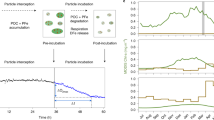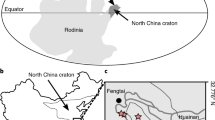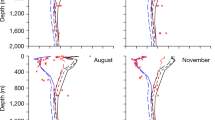Abstract
In the oceans’ high-nitrate–low-chlorophyll regions, such as the Peru/Humboldt Current system and the adjacent eastern equatorial Pacific1, primary productivity is limited by the micronutrient iron. Within the Peruvian upwelling area, bioavailable iron is released from the reducing continental margin sediments2. The magnitude of this seafloor source could change with fluctuations in the extension or intensity of the oxygen minimum zones3,4. Here we show that measurements of molybdenum, uranium and iron concentrations can be used as a proxy for sedimentary iron release, and use this proxy to assess iron release from the sea floor beneath the Peru upwelling system during the past 140,000 years. We observe a coupling between levels of denitrification, as indicated by nitrogen isotopes, trace metal proxies for oxygenation, and sedimentary iron concentrations. Specifically, periods with poor upper ocean oxygenation are characterized by more efficient iron retention in the sediment and a diminished iron supply to the water column. We attribute efficient iron retention under more reducing conditions to widespread sulphidic conditions in the surface sediment and concomitant precipitation of iron sulphides. We argue that iron release from continental margin sediments is most effective in a narrow redox window where neither oxygen nor sulphide is present. We therefore suggest that future deoxygenation in the Peru upwelling area would be unlikely to result in increased iron availability, whereas in weaker oxygen minimum zones partial deoxygenation may enhance the iron supply.
This is a preview of subscription content, access via your institution
Access options
Subscribe to this journal
Receive 12 print issues and online access
$259.00 per year
only $21.58 per issue
Buy this article
- Purchase on Springer Link
- Instant access to full article PDF
Prices may be subject to local taxes which are calculated during checkout




Similar content being viewed by others
References
Moore, C. M. et al. Processes and patterns of oceanic nutrient limitation. Nature Geosci. 6, 701–710 (2013).
Bruland, K. W., Rue, E. L., Smith, G. J. & DiTullio, G. R. Iron, macronutrients and diatom blooms in the Peru upwelling regime: Brown and blue waters of Peru. Mar. Chem. 93, 81–103 (2005).
Capone, D. G. & Hutchins, D. A. Microbial biogeochemistry of coastal upwelling regimes in a changing ocean. Nature Geosci. 6, 711–717 (2013).
Keeling, R. F., Körtzinger, A. & Gruber, N. Ocean deoxygenation in a warming world. Ann. Rev. Mar. Sci. 2, 199–229 (2011).
Mix, A. C. et al. Rapid climate oscillations in the Northeast Pacific during the last deglaciation reflect northern and southern hemisphere sources. Geoph. Monogr. Ser. 112, 127–148 (1999).
Johnson, K. S., Chavez, F. P. & Friederich, G. E. Continental-shelf sediment as a primary source of iron for coastal phytoplankton. Nature 398, 697–700 (1999).
Lam, P. J. et al. Wintertime phytoplankton bloom in the subarctic Pacific supported by continental margin iron. Glob. Biogeochem. Cycle 20, GB1006 (2006).
Raiswell, R. & Canfield, D. E. The iron biogeochemical cycle past and present. Geochem. Perspect. 1, 1–220 (2012).
Scholz, F., Severmann, S., McManus, J. & Hensen, C. Beyond the Black Sea paradigm: The isotopic fingerprint of an open-marine iron shuttle. Geochim. Cosmochim. Acta 127, 368–380 (2014).
Tribovillard, N., Algeo, T. J., Lyons, T. & Riboulleau, A. Trace metals as paleoredox and paleoproductivity proxies: An update. Chem. Geol. 232, 12–32 (2006).
Helz, G. R. et al. Mechanism of molybdenum removal from the sea and its concentration in black shales: EXAFS evidence. Geochim. Cosmochim. Acta 60, 3631–3642 (1996).
Scholz, F. et al. Early diagenesis of redox-sensitive trace metals in the Peru upwelling area: Response to ENSO-related oxygen fluctuations in the water column. Geochim. Cosmochim. Acta 75, 7257–7276 (2011).
Böning, P. et al. Geochemistry of Peruvian near-surface sediments. Geochim. Cosmochim. Acta 68, 4429–4451 (2004).
Brink, K. H., Halpern, D., Huyer, A. & Smith, R. L. The physical environment of the Peruvian upwelling system. Prog. Oceanogr. 12, 285–305 (1983).
Heinze, P-M. & Wefer, G. The history of coastal upwelling off Peru (11° S, ODP leg 112, Site 680B) over the past 650,000 years. Geol. Soc. Spec. 64, 451–462 (1992).
Lisiecki, L. E. & Raymo, M. E. A Pliocene–Pleistocene stack of 57 globally distributed benthic δ18O records. Paleoceanography 20, PA1003 (2005).
Ziegler, M., Jilbert, T., de Lange, G. J., Lourens, L. J. & Reichart, G. J. Bromine counts from XRF scanning as an estimate of the marine organic carbon content of sediment cores. Geochem. Geophys. Geosyst. 9, Q05009 (2008).
Ganeshram, R. S., Pedersen, T. F., Calvert, S. E., McNeill, G. W. & Fontugne, M. R. Glacial–interglacial variability in denitrification in the world’s oceans: Causes and consequences. Paleoceanography 15, 361–376 (2000).
Galbraith, E. D., Kienast, M., Pedersen, T. F. & Calvert, S. E. Glacial–interglacial modulation of the marine nitrogen cycle by high-latitude O2 supply to the global thermocline. Paleoceanography 19, PA4007 (2004).
Jaccard, S. L. & Galbraith, E. D. Large climate-driven changes of oceanic oxygen concentrations during the last deglaciation. Nature Geosci. 5, 151–156 (2012).
Nameroff, T. J., Calvert, S. E. & Murray, J. W. Glacial–interglacial variability in the eastern tropical North Pacific oxygen minimum zone recorded by redox-sensitive trace metals. Paleoceanography 24, PA1010 (2004).
Muratli, J. M., Chase, Z., Mix, A. C. & McManus, J. Increased glacial-age ventilation of the Chilean margin by antarctic intermediate water. Nature Geosci. 3, 23–26 (2010).
Sarmiento, J. L., Gruber, N., Brzezinski, M. A. & Dunne, J. P. High-latitude controls of thermocline nutrients and low latitude biological productivity. Nature 427, 56–60 (2004).
Meissner, K. J., Galbraith, E. D. & Völker, C. Denitrification under glacial and interglacial conditions: A physical approach. Paleoceanography 20, PA3001 (2005).
Schrader, H. Peruvian coastal primary palaeo-productivity during the last 200,000 years. Geol. Soc. Spec. 64, 391–410 (1992).
Murray, R. W., Leinen, M. & Knowlton, C. W. Links between iron input and opal deposition in the Pleistocene equatorial Pacific Ocean. Nature Geosci. 5, 270–274 (2012).
Elrod, V. A., Berelson, W. M., Coale, K. H. & Johnson, K. S. The flux of iron from continental margin sediments: A missing source for global budgets. Geophys. Res. Lett. 31, L12307 (2004).
Moore, J. K. & Braucher, O. Sedimentary and mineral dust sources of dissolved iron to the world ocean. Biogeosciences 5, 631–656 (2008).
Schunck, H. et al. Giant hydrogen sulfide plume in the oxygen minimum zone off Peru supports chemolithoautotrophy. PLoS ONE 8, e68661 (2013).
McLennan, S. M. Relationships between the trace element composition of sedimentary rocks and upper continental crust. Geochem. Geophys. Geosyst. 2, 1021 (2001).
Acknowledgements
Financial support for this study was provided by the 7th Framework Program of the European Union (Marie Curie IOF to F.S., BICYCLE, Project No. 300648) and the German Research Foundation through Collaborative Research Centre 754 ‘Climate-Biogeochemistry Interactions in the Tropical Ocean’ (www.sfb754.de/en). The US National Science Foundation supported J.M. (Grant No. 1029889) and A.C.M. (Grant No. 1131834). We thank A. Bleyer, B. Domeyer, J. McKay and A. Ungerer for assistance in the laboratory and A. Schmittner for insightful comments on the manuscript.
Author information
Authors and Affiliations
Contributions
F.S., J.M., A.C.M. and C.H. designed the study; F.S. carried out the laboratory work; R.R.S. guided the coring campaign and contributed radiocarbon dates; F.S. wrote the manuscript with contributions from all co-authors.
Corresponding author
Ethics declarations
Competing interests
The authors declare no competing financial interests.
Supplementary information
Supplementary Information
Supplementary Information (PDF 1465 kb)
Rights and permissions
About this article
Cite this article
Scholz, F., McManus, J., Mix, A. et al. The impact of ocean deoxygenation on iron release from continental margin sediments. Nature Geosci 7, 433–437 (2014). https://doi.org/10.1038/ngeo2162
Received:
Accepted:
Published:
Issue Date:
DOI: https://doi.org/10.1038/ngeo2162
This article is cited by
-
Can green hydrogen production be used to mitigate ocean deoxygenation? A scenario from the Gulf of St. Lawrence
Mitigation and Adaptation Strategies for Global Change (2023)
-
Biological matter enhanced iron release from shallow marine bioturbated sediments: a case study of Late Cretaceous sandstone, northern Saudi Arabia
International Journal of Earth Sciences (2023)
-
The Peruvian oxygen minimum zone was similar in extent but weaker during the Last Glacial Maximum than Late Holocene
Communications Earth & Environment (2022)
-
The Angola Gyre is a hotspot of dinitrogen fixation in the South Atlantic Ocean
Communications Earth & Environment (2022)
-
Periodic changes in the Cretaceous ocean and climate caused by marine redox see-saw
Nature Geoscience (2019)



